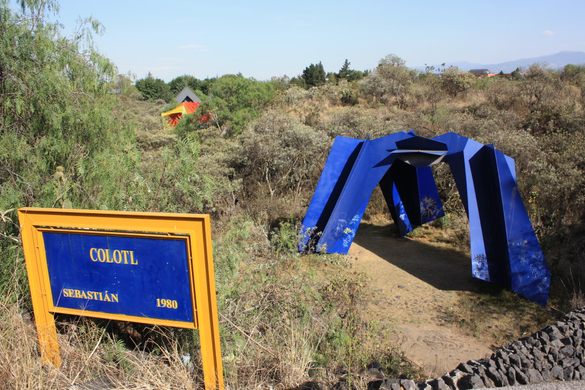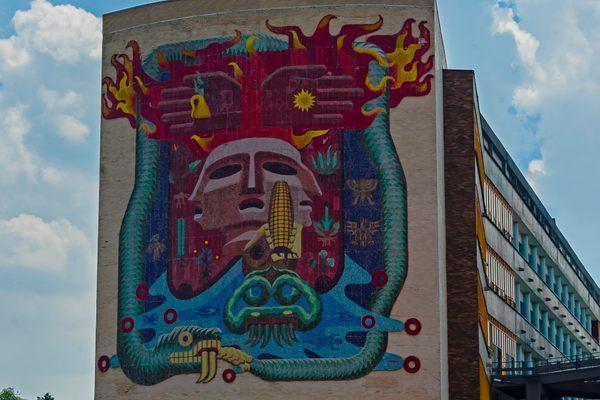Espacio Escultórico (Sculptural Space)
A series of abstract sculptures pop up from an otherworldly volcanic landscape.
Near the southern edges of Mexico City’s urban sprawl, you can find the pedregales (stony grounds). These fields of volcanic stone caused by the eruptions of the Xitle volcano (which also caused the abandonment of the pre-Columbian city of Cuicuilco) are some of the most unique geological features of this massive metropolis. They are also home to many important cultural institutions built atop the former lava flows. Perhaps chief among them is the Central Campus of the National Autonomous University of Mexico (UNAM).
Since its 1952 inauguration, this central campus (known locally as C.U. for Ciudad Universitaria) has had a robust history. It was the focal point of the 1968 Summer Olympics, the site of a year-long student strike from 1999 to 2000, and was declared a UNESCO World Heritage Site in 2007. The Espacio Escultórico (Sculpture Space) is part of the central campus and is where large, colorful, abstract sculptures decorate and enhance the natural volcanic pedregales they sit atop.
The Espacio Escultórico was the brainchild of sculptor Federico Silva. It was inaugurated on April 23, 1979. The space contains six sculptures in total, in addition to one representing the park itself.
“Las Serpientes del Pedregal y Ocho Conejos” (“The Snakes of the Pedregal and Eight Rabbits”) by Federico Silva are a dark series of nested triangular figures and an origami-like animal carved out of volcanic stone. “Ave Dos” (“Bird Two”) by Hersúa is an orange abstract geometrical shape. “Coatl” (Náhuatl for “snake”) by Helen Escobedo is comprised of a collection of off-set square outlines painted in shades of warm colors. “Colotl” (Náhuatl for “scorpion”) by Sebastián is a large metallic abstract interpretation of the animal, painted electric blue. “Corona del Pedregal” (“Crown of the Pedregal”) by Mathias Goeritz is a series of five long, thin, pink pentagonal pyramids. Manuel Felguérez’s “Variante de la Llave de Kepler” (“Variant of Kepler’s Key”) is a multi-colored, metallic abstract figure.
The final structure represents Espacio Escultórico itself. A ring with an outside diameter of 393 feet (120 meters) topped by 74 massive stone prisms are meant to represent a pre-Columbian worldview. In the center of this ring, the undisturbed pedregal landscape can be fully appreciated.
Know Before You Go
The nearest metro station is Universidad on Line 3. The closest Metrobús station is Centro Cultural Universitario on Line 1 (red).























Follow us on Twitter to get the latest on the world's hidden wonders.
Like us on Facebook to get the latest on the world's hidden wonders.
Follow us on Twitter Like us on Facebook